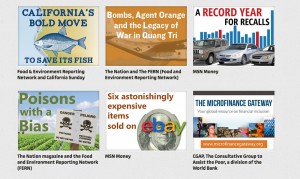Expansion of digital news ventures and growth in nontraditional sources of funding are breathing new life into journalism, creating nearly 5,000 new full-time professional jobs in the past few years, according to a report released today.
The Pew Research Center’s annual report on the industry, State of the News Media 2014, found that nearly 3,000 of the new jobs were created by 30 large digital-only news outlets, including many covering global news.
Related story: “8 Global Journalism Opportunities”
“Whether it’s Buzzfeed or Mashable, or Businesses Insider or Vice, there’s been a very strong increase in their hiring of journalists to do original reporting,” said Amy Mitchell, Pew’s director of journalism research. “There’s a sense of energy that hasn’t existed inside the industry for quite some time.”
While this fresh round of hiring is building momentum and providing hope for the news industry as a whole, the report notes that it is still not at a scale large enough to offset the continued shrinking of print advertising revenue, which has led to hefty job losses for newspapers.
“When we look at where these outlets fit within the whole of the journalism that consumers in our country are receiving, it’s such a small sliver, a small piece,” Mitchell said.
Advertising made up about 69 percent of total financial support for the news industry in the U.S. last year, but its business model “is in a state of churn” the report said. “Print advertising continues its sharp decline,” the report added.
Pew analysts estimated for-profit digital news outlets generated at least $500 million in advertising revenue last year, which would represent only 1 percent of ad revenue from all types of news companies. Overall, including all sources of revenue across the various news sectors, Pew estimated the U.S. news industry generates slightly more than $60 billion a year.
Audience-generated revenue is growing in share and in dollars, accounting for 24 percent of the total revenue for the industry last year. However, this is driven by increased prices for print products and more news outlets employing digital paywalls, not from a growing readership, according to the report.
Related story: “The Big Shift in Newspaper Revenue”
Mitchell noted there is optimism around the fact that the new digital news outlets have “some new revenue streams attached to them,” primarily through entrepreneurs, venture capitalists, and philanthropists emerging from the tech industry.
These players are investing in new ventures and traditional ones. They include Amazon founder Jeff Bezos, who purchased The Washington Post last year, and eBay founder Pierre Omidyar, who pledged a $250 million investment into FirstLook Media — a startup by a group of noted investigative journalists.
Digital-native news outlets were hiring in 2013, according to the report, even as traditional news organizations downsized. The report noted that Buzzfeed’s editorial staff grew by 170 positions last year, Gawker added 132 editorial jobs and Business Insider added 32. So far in 2014, it added, Vice Media has added 50 new people.
Another trend noted in the report is a large increase in advertising revenue tied to digital video, which jumped 44 percent from 2012 to 2013. The report said digital news outlets are investing in digital video, even though the ad revenue it generates still only amounts to 10 percent of all digital advertising dollars in the U.S.
The report also revealed another challenge presenting itself through social media, prompting news outlets to rethink their relationships with their audiences. Mitchell said that relationship has become more “fleeting” and “less deeply engaged.”
“What we’ve seen occurring on Facebook in particular…is that the people don’t necessarily go there looking for news, but they find news there, they bump into it,” Mitchell said. “They might come to your news site, they might follow that link that their friend shares with them, but they’re not necessarily going to come back again, or even remember which outlet it was that they landed on.”
A study accompanying the report showed that half of Facebook users get news from the social media site, but only 22 percent see it as means to get news, with the other 78 percent only encountering news when using the site for other purposes.
“It’s an important way of getting audience and finding new audience and getting your content out,” Mitchell said. “But it’s different than that relationship, at least among traditional outlets, that you may have fostered for so many years.”
Follow AJR on Twitter: @AmJourReview









Leave a Comment